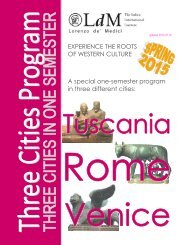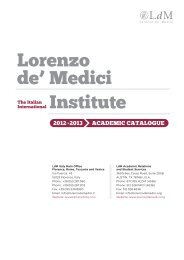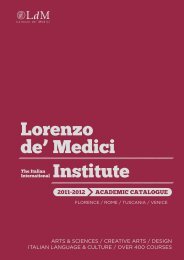aCademiC Catalog 2013-2014 - Lorenzo de Medici
aCademiC Catalog 2013-2014 - Lorenzo de Medici
aCademiC Catalog 2013-2014 - Lorenzo de Medici
Create successful ePaper yourself
Turn your PDF publications into a flip-book with our unique Google optimized e-Paper software.
as well as <strong>de</strong>bates in aesthetics and theory, such as the <strong>de</strong>cline<br />
of Mo<strong>de</strong>rnism. Key architects and studios are examined.<br />
The perspective is global but European and Italian figures,<br />
movements, works and events are not ignored.<br />
Prerequisites: ART 165 History of Architecture, or equivalent<br />
Sustainable Architecture<br />
ARC 320 F<br />
Cr: 3; Contact hrs: 90<br />
Sustainability is a characteristic of a process or state that can<br />
be maintained at a certain level in<strong>de</strong>finitely. Our current lifestyle<br />
is not sustainable because we base our energy requirements on<br />
burning fossil fuels that are running out, causing global warming<br />
and pollution. The key aim of the sustainable architecture<br />
approach is to help resolve the present energy crisis by<br />
<strong>de</strong>signing self-sufficient buildings. The two basic principles<br />
applied are: reduction of energy needs and use of renewable<br />
forms of energy (solar, wind, geothermic, hydroelectric or<br />
biomass). Other topics touched upon in the course are:<br />
use of local building materials, study of the local traditional<br />
passive strategies (to create a pleasant home <strong>de</strong>spite climate<br />
conditions), encouraging a sustainable lifestyle, co-housing.<br />
Prerequisites: Architecture majors of junior standing<br />
Architecture in its Environment<br />
ARC 340 F<br />
Cr: 3; Contact hrs: 90<br />
The course goal is to learn a method to un<strong>de</strong>rstand the relation<br />
between architecture and urban context and to be able to<br />
<strong>de</strong>sign a relevant architectural project. Emphasis is on the<br />
vertical and horizontal dimensions of cities and towns, and on<br />
the analysis of shapes and uses of the urban space. The main<br />
course project relates to a specific urban situation. The project<br />
process starts with extensive on-site case study analysis of the<br />
site (with outdoor walking and sketching), historical context,<br />
and the urban surroundings. In class stu<strong>de</strong>nts will <strong>de</strong>velop,<br />
examine and discuss the main elements, themes and issues<br />
of the project. The completed project inclu<strong>de</strong>s sketches, site<br />
plans, architectural plans, elevations and sections, as well as a<br />
presentation <strong>de</strong>livered in class.<br />
Prerequisites: Architecture majors of junior standing<br />
Architecture Studio: Special Topics<br />
ARC 380 F<br />
Cr: 3; Contact hrs: 90<br />
This course focuses on advanced <strong>de</strong>sign projects, which are<br />
based largely on a theme of local or national importance. It is<br />
usually concerned with the comprehensive analysis and <strong>de</strong>sign<br />
of mo<strong>de</strong>rn medium/large scale complexes and public buildings<br />
such as a museum, airport, railway stations, waterfront, or<br />
emergency construction. The course is organized to equip<br />
stu<strong>de</strong>nts with the skills for the comprehensive <strong>de</strong>sign and<br />
implementation of architectural projects of notable complexity<br />
and scale.<br />
Prerequisites: Architecture majors of junior standing<br />
Fashion Design, Marketing and<br />
Merchandising<br />
Introduction to the Fashion Industry<br />
FAS 100 F<br />
Cr: 3; Contact hrs: 45<br />
This core class provi<strong>de</strong>s stu<strong>de</strong>nts with an overview of the<br />
fashion industry from research and <strong>de</strong>sign to the marketing of<br />
the finished product. Potential career opportunities within the<br />
field are examined, and the course briefly looks at the historical<br />
origins of fashion, especially the fabric, yarn and knitwear sector<br />
centered on Florence and the “Ma<strong>de</strong> in Italy” phenomenon.<br />
Stu<strong>de</strong>nts will acquire knowledge of basic industry terms and<br />
of the process of apparel production, from the concept to the<br />
consumer.<br />
Principles of Apparel Design<br />
FAS 120 F<br />
Cr: 3; Contact hrs: 45<br />
Stu<strong>de</strong>nts learn clothing terminology as it pertains to different<br />
garments, silhouettes, and their components. The course<br />
examines the elements and principles of fashion <strong>de</strong>sign, and<br />
introduces CAD software for the production of flats and<br />
presentations.<br />
Fashion Figure Drawing<br />
FAS 130 F<br />
Cr: 1; Contact hrs: 45<br />
This entry-level drawing class studies the elements of the<br />
figure in fashion proportion and in fashion poses. Stu<strong>de</strong>nts<br />
work to <strong>de</strong>velop a personal line, style, and personality in figure<br />
presentation. Stu<strong>de</strong>nts will be exposed to the tools, concepts<br />
and techniques of figure drawing. They will discuss, explore and<br />
practice a variety of techniques, focusing on un<strong>de</strong>rstanding<br />
and recreating three-dimensional forms on paper. Through<br />
lectures, <strong>de</strong>monstration and a great <strong>de</strong>al of drawing stu<strong>de</strong>nts<br />
will have the opportunity to <strong>de</strong>velop their knowledge and skills<br />
in replicating the human form.<br />
Design Sewing Techniques<br />
FAS 150 F<br />
Cr: 3; Contact hrs: 60<br />
In this course stu<strong>de</strong>nts learn the basics of sewing from a<br />
technical point of view. During the semester the stu<strong>de</strong>nt will<br />
learn how to use various sewing machines, both industrial and<br />
household. Stu<strong>de</strong>nts will also study and then execute all the<br />
basic stitches used in the apparel industry such as basting,<br />
hemming, French seam, mock French seam, flat-felled seam<br />
and others. In addition stu<strong>de</strong>nts will sew si<strong>de</strong> seams, darts,<br />
pleats, princess lines, necklines, as well as different zipper and<br />
pocket applications, and interfacings. At the end of the course<br />
the stu<strong>de</strong>nt should be able to construct a simple project.<br />
Design Sewing Techniques (Summer only)<br />
FAS 151 F<br />
Cr: 3; Contact hrs: 45<br />
In this course stu<strong>de</strong>nts learn the basics of sewing from a<br />
technical point of view. During the semester the stu<strong>de</strong>nt will<br />
learn how to use various sewing machines, both industrial and<br />
household. Stu<strong>de</strong>nts will also study and then execute all the<br />
basic stitches used in the apparel industry such as basting,<br />
hemming, French seam, mock French seam, flat-felled seam<br />
and others. In addition stu<strong>de</strong>nts will sew si<strong>de</strong> seams, darts,<br />
pleats, princess lines, necklines, as well as different zipper and<br />
pocket applications, and interfacings. At the end of the course<br />
the stu<strong>de</strong>nt should be able to construct a simple project.<br />
Fashion Illustration I<br />
FAS 160 F<br />
Cr: 3; Contact hrs: 90<br />
This course for beginning stu<strong>de</strong>nts explores the world of fashion<br />
illustration. Stu<strong>de</strong>nts will learn how to sketch a fashion figure,<br />
add garments, and ren<strong>de</strong>r different materials using media like<br />
colored pencils and markers. Special attention will be given to<br />
coloring and shading. During the semester there will be site<br />
visits to such locations as the Ferragamo Museum and the<br />
Gallery of Costume at the Pitti Palace, as well as fashion tra<strong>de</strong><br />
fairs and fashion <strong>de</strong>sign studios. Stu<strong>de</strong>nts will also learn about<br />
the job of a fashion <strong>de</strong>signer and the main steps to organize a<br />
collection. In addition they will illustrate their own <strong>de</strong>signs on<br />
the fashion figure showing their own style and taste in fashion.<br />
Fashion Illustration I (Summer only)<br />
FAS 161 F<br />
Cr: 3; Contact hrs: 45<br />
This course for beginning stu<strong>de</strong>nts explores the world of fashion<br />
illustration. Stu<strong>de</strong>nts will learn how to sketch a fashion figure,<br />
add garments, and ren<strong>de</strong>r different materials using media like<br />
colored pencils and markers. Special attention will be given to<br />
coloring and shading. During the semester there will be site<br />
visits to such locations as the Ferragamo Museum and the<br />
Gallery of Costume at the Pitti Palace, as well as fashion tra<strong>de</strong><br />
fairs and fashion <strong>de</strong>sign studios. Stu<strong>de</strong>nts will also learn about<br />
the job of a fashion <strong>de</strong>signer and the main steps to organize a<br />
collection. In addition they will illustrate their own <strong>de</strong>signs on<br />
the fashion figure showing their own style and taste in fashion.<br />
School of Design FLORENCE<br />
LdM Aca<strong>de</strong>mic <strong>Catalog</strong> <strong>2013</strong>-<strong>2014</strong><br />
105





